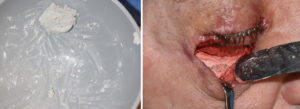
Orbital dystopia is always most clearly seen in pictures as the eyes look ‘off’. This is where patients will notice it the most as well as when looking directly in the mirror. (or in selfies) There will be one good eye and the affected eye will usually be sitting lower. It is rare that the affected eye is the higher one. For unknown reasons in my experience vertical orbital dystopia occurs much more frequently in the right eye.
The most important step when the eyes appear at different levels is to make the proper diagnosis. This will require a 3D CT scan of the entire face and not just the orbits. Aesthetic (non-craniofacial) orbital dystopia usually has other facial asymmetries as well particularly of the superior brow bone and the inferior cheeks. The entire orbital skeletal box is lower. As a result, the eyebrow and brow bone will also be lower, the upper eyelid may have some mild ptosis and the cheek will be flatter and asymmetric.


In the correction of vertical orbital dystopia, it is also important to be aware of what may happen to the upper eyelid-globe relationship. In most cases of congenital orbital dystopia the upper eyelid follows the eye to maintain a normal appearing upper eyelid to globe relationship. But as the lower eye is surgically lifted, the eye can be come more buried under the upper eyelid. Ptosis repair may be needed to get the eyelid back up higher on the iris.
Dr. Barry Eppley
Indianapolis, Indiana


